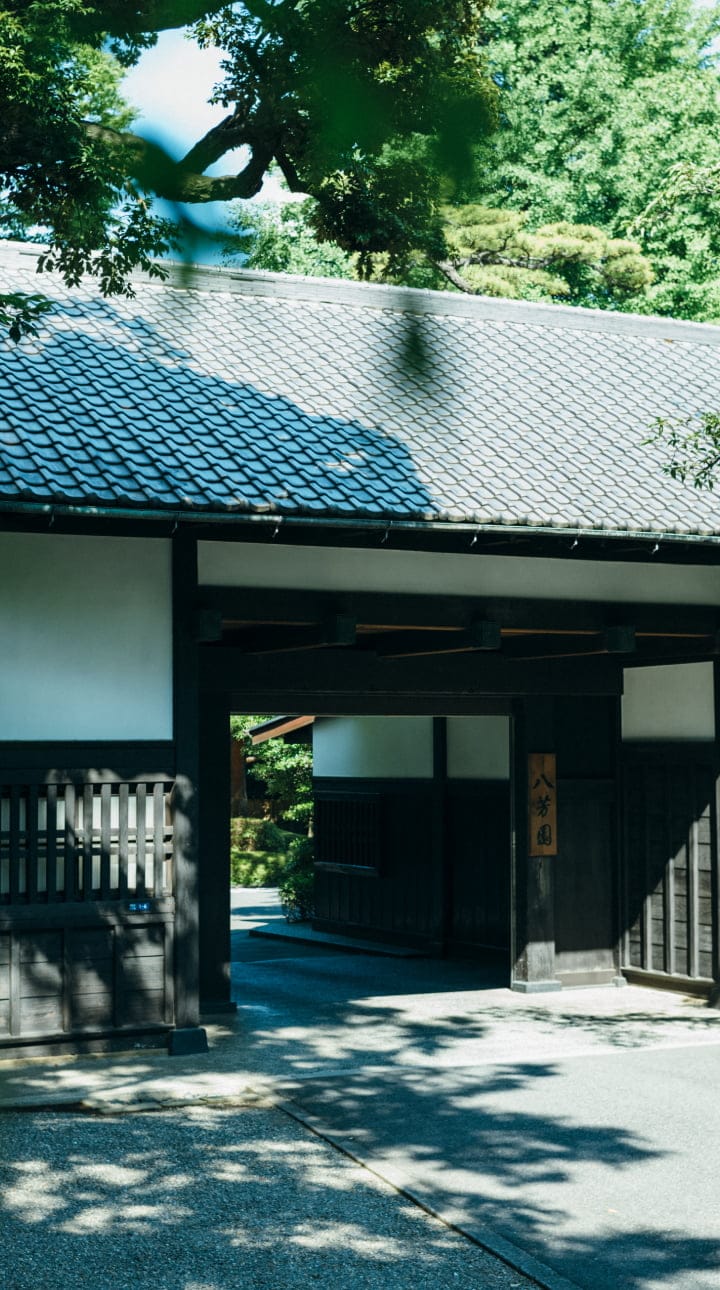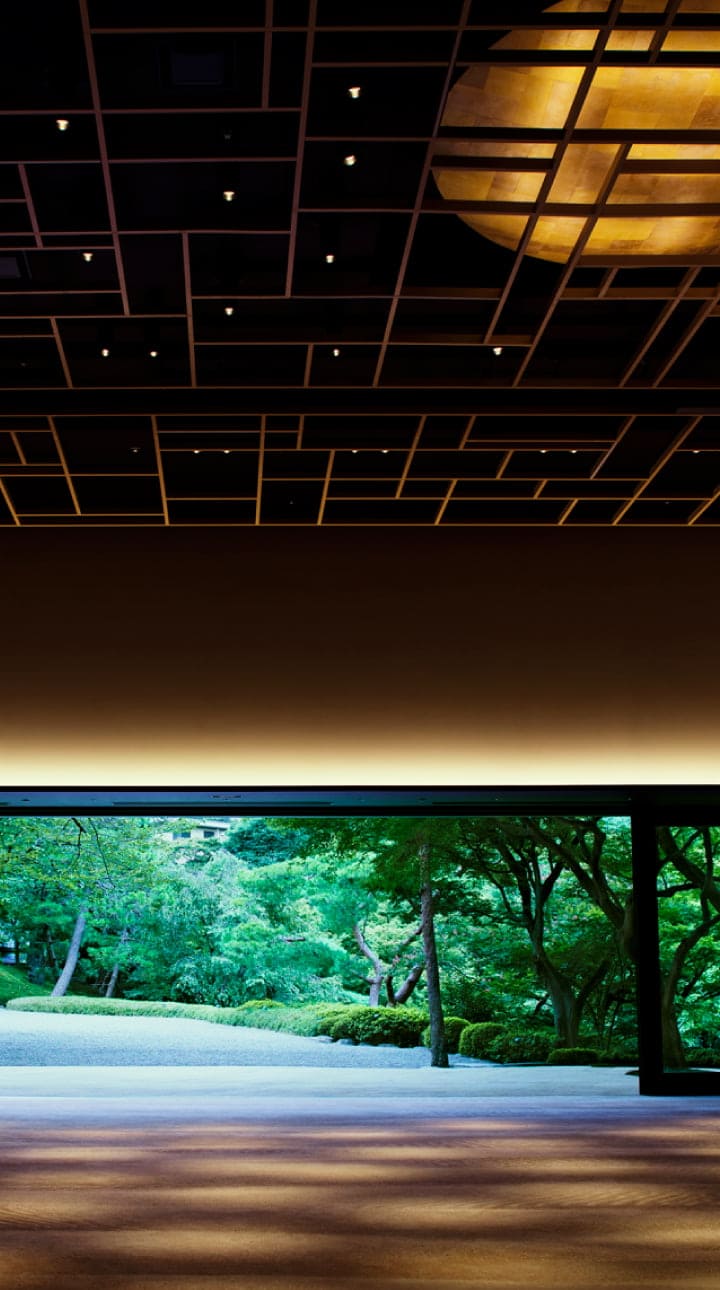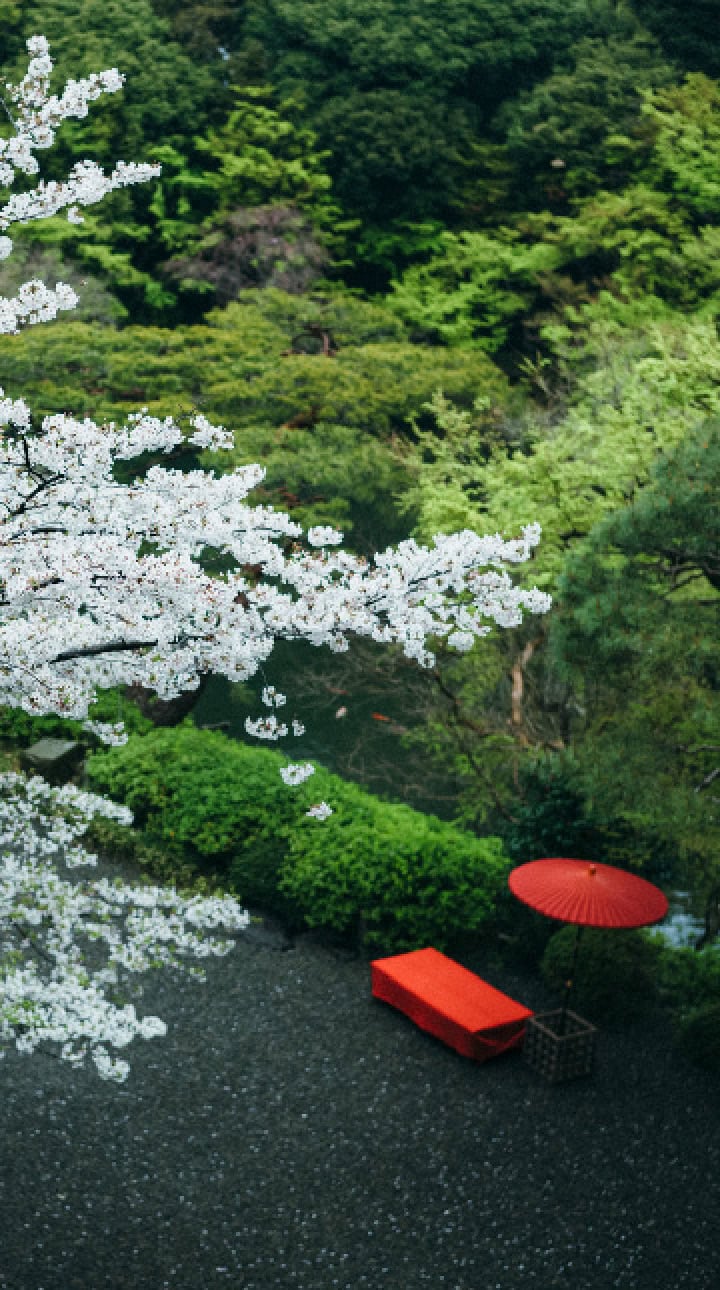This vast garden was first built 400 years ago at the beginning of the Edo period in Shirokanedai, Tokyo. HAPPO-EN’s origins trace back to a Japanese restaurant established on this site. This page shares the story of HAPPO-EN’s eighty-year journey since its founding, its beauty expressed through food, business, and hospitality, along with our vision for the future.
The history of HAPPO-EN
Our History
HAPPO-EN handles a number of businesses, including dining, wedding, and business event production as well as planning. We originated from a Japanese garden that has been lovingly preserved by successive owners over generations, and we are founded on a heartfelt commitment to serve the food culture of the nation and promote Japanese tourism.
Past Owners
At the beginning of the Edo period, the land that HAPPO-EN now stands was the residence of Hikozaemon Okubo, an adviser and close confidant to the period’s first shogun, Ieyasu Tokugawa. Hikozaemon chose this place as his final abode. After his passing, and following the transition from the Edo period to the Meiji Restoration, the property came into the hands of businessman Seiichiro Shibusawa (1838–1912), later known as Kisaku Shibusawa, toward the end of the Meiji period. At that time, a plum garden was planted, and to this day, beautiful blossoms decorate these old plum trees each year. As Japan entered the Taisho period, the Shibusawa residence was purchased by businessman Fusanosuke Kuhara (1869–1965), a co-founder of Hitachi Manufacturing. His passion led to the creation of one of Tokyo’s most prominent gardens and the core of HAPPO-EN. When asked why he purchased the land, he responded, “That one pine tree captivated me.” The pine tree he spoke of was one sent by the third Tokugawa shogun, Iemitsu Tokugawa, as a gift to Hikozaemon when he was bedridden. This tree flourished for more than 400 years, and though it withered after the war, the Japanese cornel tree believed to be Hikozaemon’s bonsai still exists within the garden.
Creating a garden by “arranging nature”
Today, you can experience all four seasons in the gardens, from the veil of cherry blossoms in the spring and the cool breezes blowing through the vivid greenery of summer, to the colorful array of leaves and the moon in autumn, and the subtle yet profound snowscapes with the migratory birds visiting the ponds in winter. The current layout of the gardens was created by Kuhara, who had the unique idea of “arranging the garden.” He would often say, “I would never do something as offensive as try to create my own garden. I am simply arranging nature,” and he wouldn’t even allow the gardeners to cut a single blade of grass on their own. It’s said he paid such close attention that he knew every branch of every plant in the garden. HAPPO-EN is still taken care of with just as much thought by its gardeners to this day.
Every tree and blade of grass has a purpose
The Dawn of HAPPO-EN
By 1950, the chaos of postwar times had begun to settle. At the time, many Japanese restaurants were operating in the Ginza area, and an acquaintance of Toshitsuka Hase, who would become the founder of HAPPO-EN, suggested renting out Kuhara’s abode and part of his garden to run a restaurant together. At first, Toshitsuka declined the offer, but after visiting the garden, he immediately changed his mind. After losing the war, there were fears that the traditions and beauty of Japan would be lost forever, especially because of the postwar government. He was deeply moved and happy that a garden with such a rich history remained almost unscathed by the war.
Japanese cuisine takes note of the changes in colors and shapes of things and pays special attention to the seasons, hence why it’s considered culinary art. And being able to enjoy this experience in the perfect environment takes it to a whole new level. This thought is what made Toshitsuka reconsider opening a restaurant, and he was given the opportunity to share this business plan with Kuhara. When Kuhara was reluctant about renting out his beloved garden, Toshitsuka responded by saying, “Tokyo should be the face of Japan. If you let me use this garden, I don’t want them to simply be a place where food and drinks are served. I want to create a place that shares the richness of Japanese culture with guests from abroad and a place where Japanese guests can feel at home.” When Kuhara heard these words, he agreed to rent part of his residence and garden to be used and named the restaurant HAPPO-EN (which means “garden with eight views”).
His inspiration for the name came from:
1. Founder Toshitsuka Hase’s company Hase Kanko always opened new stores on the eighth of the month.
2. The garden was beautiful from all eight directions, with no front or back.
3. The word “happo” had a nice ring to it.
4. The word “en” means “connected” and had a strength to it.
Food
Dining
With Japanese cuisine, the environment in which it is served is also important, and we want to share that value with guests from Japan and abroad. HAPPO-EN continues to honor the vision of its founder by serving people through food.
Sharing the traditions of Japan from the heart of Tokyo
HAPPO-EN opened in Shirokanedai, Tokyo, as a traditional Japanese restaurant. Even though postwar reconstruction was going well and people’s lives were slowly returning to normal, it was still not a time when families could casually go out to eat together. Founder Toshitsuka Hase wanted to welcome families and the general public, including the youth and women, and not just create a spot for the elite or those from certain industries to socialize. That desire led him to rack his brain to come up with ideas.
One tactic he used right after opening was to place posters inside the train cars on Tokyo’s Yamanote Line and in the Meguro, Gotanda, and Shinagawa stations.
“Leave the summer heat at the door.”
“The oasis of Tokyo!”
“Great for large and small gatherings and garden parties.”
People saw these posters and began to flock to HAPPO-EN. The restaurant received praise for being able to admire the lush greenery and koi carp ponds while taking a stroll and the wonderful cool breezes while dining. HAPPO-EN has since incorporated more seasonal elements, like hanging carp streamers along its eaves amidst the garden’s fresh greenery in May to celebrate Children’s Day, and offering iris sake and chimaki dumplings, creating a nostalgic space to enjoy this traditional festival. Toshitsuka’s dream of “Recreating traditional Japan in the heart of Tokyo” has slowly but surely become a reality.
Sharing the taste of Japan with the world
The space that had once served as Fusanosuke Kuhara’s home became a restaurant and was renamed “Kochuan,” and it continues to operate in the garden to this day. These gardens were designed by Kuhara and captivated founder Toshitsuka Hase, and all of the restaurant’s private rooms boast incredible views. The unique Japanese cuisine served here uses select seasonal ingredients from around the country and is prepared using methods that the chefs deem most suitable. Kochuan lets you enjoy Japanese cuisine in an environment second to none and has long been cherished by guests from Japan and abroad. We want to be a place where guests from abroad can learn about Japanese culture, and where Japanese guests can feel at home. We carry on our founder’s vision, pursuing a variety of dining experiences as a place where many people can encounter Japanese ingredients and the traditional skills of our craftsmen.
Kochuan
ご予約はこちらWhat we do
Business
HAPPO-EN began in the food industry and is now involved in many business areas. We are using the expertise and passion we developed over the years to take on new challenges and break free from traditional molds.
Becoming a company that can host customers’ special days
The 1950s were a period of huge economic growth for Japan, changing the lives of everyone who had been living frugally after the war. There was also a large shift in how people viewed marriage. In April 1960, the HAPPO-EN Western Hall was erected, and with three floors above ground and a basement, it could hold large banquets and wedding ceremonies. This development eventually led to the creation of our bridal business, which has been faithfully carried on to this day. We evolved from serving people through food to becoming a company that provides hospitality on their special days. This business expansion allowed HAPPO-EN to develop our planning and production abilities and a “heart for hospitality” that we still hold dear.
HAPPO-EN went from weddings to full-service event management
HAPPO-EN has produced countless weddings for our guests, and we think that many people now view us as a bridal company. However, we are involved in more than just bridal and cuisine businesses, as we also handle business event production and DX promotion projects. We can use the planning and production skills we honed from our wedding business to help society in new ways. HAPPO-EN has already broken the mold of full-service event management by handling local government and tourism-related projects. We are working together with local governments to develop and propose local ingredients and cuisine, creating synergy between people, between people and regions, and urban and rural areas. Such encounters will also lead more people to visit rural areas, and as more cultural exchanges are born through HAPPO-EN, new value will be created. We want to become the front door to Japanese culture and a hub for creating cultural exchanges, sharing the beauty of Japan in a condensed form. We will work together with local governments and traditional craftsmen to share the beauty of Japan on both a local and a global scale.
Japanese “Omotenashi”
Hospitality
Since our founding, HAPPO-EN has welcomed guests from Japan and abroad. We take note of minute details to connect heart-to-heart, staying aware of guests’ gazes, actions, hand gestures, and expressions so we can respond to their needs naturally. HAPPO-EN has nurtured its heart for hospitality by hosting weddings that celebrate couples and their loved ones on their special day.
Hospitality at HAPPO-EN
What does hospitality look like at HAPPO-EN? Here is an iconic example from a member of our staff.
This happened right after I joined HAPPO-EN. I was standing near the entrance and learning how to see off guests. There was a couple who had left three of their bags with us, and they came to pick them up as they headed out. These guests had held their wedding ceremony at our garden the day before. A senior employee who was passing by told me to help the couple. I of course said I would, and as I started making my way over, my senior asked me, “Do you know what to do?” I said, “Yes. I’ll get their bags, take them to the gate, and see the guests off.” To which my senior responded, “Is that the best that HAPPO-EN has to offer?” So I said, “Then I’ll take their bags to the top of the hill,” to which they again asked, “Is that really the best we can do?” I thought for a moment and suggested, “I can take them to the ticket gate at Shirokanedai Station and say, ‘Congratulations on your marriage. I apologize that this is as far as I can see you off, but I hope you have a wonderful day.’” My senior replied, “Now that’s more like it.” I’m still reminded of this encounter during my first year at HAPPO-EN every time I help our guests.
There is no correct way to provide hospitality. Just because you have a well-thought-out manual and stick to it doesn’t mean it will be meaningful to the guest. Which is why all of the staff at HAPPO-EN think about creating the greatest value at that time and moment for each customer. For example, we would never just respond to a customer’s request by saying “No.” We promise to consider all of the options and alternatives to provide our guests with services that go above and beyond.
Hospitality through food
Wedding ceremonies in Japan were originally held at home. On the day of the wedding, people would sprinkle water in front of their door, decorate the home with seasonal flowers, and consider who was attending when deciding what seasonal ingredients and dishes to serve their guests. Today, most ceremonies are held at wedding venues like hotels and restaurants, which is why it is our job to act in place of the couple and their families to prepare a delicious meal that conveys that same hospitality.
At one of our wedding receptions, we served dishes filled with the delicious tastes of the couple’s hometown by using rice and vegetables grown by their grandparents. In another example, we recreated the first pumpkin gratin that the bride had made for the groom, and he recalled how touched he was by its deliciousness, leading to a warm round of applause.
When we hold wedding receptions, we always save the menu details in a file labeled “(Bride) and (Groom)’s Wedding Menu,” so that the next time they visit — whether in a few years or decades to celebrate their anniversary or another family milestone — we can welcome them with a nostalgic meal. HAPPO-EN strives to be a heartfelt home through food, a place where guests are always welcome to return.
Our Vision
Sharing the Beauty of Japan
It has been more than 80 years since our founder, enthralled by the beautiful Japanese gardens, decided to open a restaurant here. Today, we are inspired by the charms of Japan. Its abundant nature and changing seasonal scenery, its unique history and culture, its traditional crafts and industries, nurtured in each region, create a unique ecosystem of beauty unmatched by any other country. We believe there are many hidden gems within Japan that remain undiscovered. Beyond these visible elements, the Japanese spirit, including its hospitality, is also one of the reasons why foreign visitors perceive Japan as "beautiful." We are determined to preserve the beauty of Japan that has been built over time and update its value to keep pace with the times. With this in mind, we have adopted the purpose of "Making Japan Beautiful," aiming to further enhance the beauty of Japan's landscapes, culture, and people's hearts. Because encountering beautiful things and experiences will surely transform people's hearts. We believe that in the future, Japan will become an even more beautiful and captivating country.



